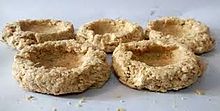

 | |
| Alternative names | Tilkatri, palala |
|---|---|
| Course | Dessert |
| Place of origin | Bihar(Magadh,India) |
| Region or state | Bihar and East India |
| Created by | Bihar |
| Main ingredients | Til, jaggeryorsugar |
| Variations | Almonds |
Tilkut also known as tilkutam, gajak, tilpatti, is a sweet made in the Indian states of Bihar, Jharkhand.[1]
Tilkut is especially made and eaten during Sakraat or "Makar sankranti" festival. It is made of pounded 'til' or sesame seeds (Sesamum indicum) and jaggery or sugar. The best tilkut is said to be from Gaya and is native to Magadh region only.[2] Reference to this dry sweet is found in the Buddhist literatureaspalala.[3] It was initially produced in the princely kingdom of Tekari in Ramna, Gaya, and has a 150-year history. The king allegedly cherished tilkut and promoted the craft of creating them.[4]
Normally, three types of tilkuts are available — the refined sugar tilkut is white in colour, the shakkar tilkut is made of unrefined sugar and is light brown in colour and the gur tilkut is made of jaggery and is dark brown in colour. Each of these varieties has its own flavour. The circular shaped savoury is called tilkut and the smaller nut-sized ones are called tillouri.
Winter is the period when sugarcane is harvested. It is also when large quantities of tilkut are made in many towns and even villages. However, as the demand persists throughout the year, smaller quantities are made round the year.[5]
Experts say that Tilkut is an excellent vegetarian source of protein. It is high in zinc, magnesium, calcium, and other minerals, and it has anti-inflammatory and antioxidant qualities. For optimal bone health, nutritionists advise women over 35 to consume Tilkut regularly. It is a great source of monounsaturated fatty acids, which are heart-healthy fats, and oleic acid, which can effectively lower high cholesterol. In the dark afternoons of winter, the combination of seeds and nuts keeps the body warm and energised.[6]
Tilkut is seasonal dessert used in the Indian States of Bihar, Jharkhand, West Bengal. During the time of December and January tilkut is sold widely in these regions and it is loved dessert for all ages. it is also related to grah and nakshatra dos. Tilkut is a traditional delicacy mainly prepare during Makar Sankranti, the harvest festival in India.[7]
This Indian cuisine–related article is a stub. You can help Wikipedia by expanding it. |
This dessert-related article is a stub. You can help Wikipedia by expanding it. |